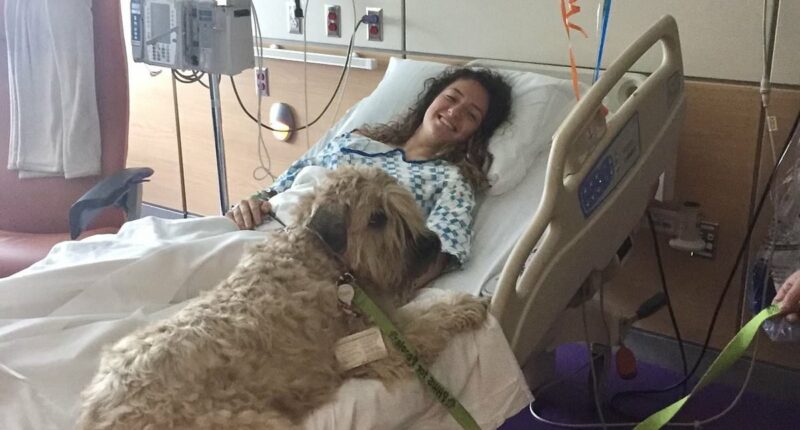Share this @internewscast.com
On the soccer field, Relly Ladner felt a sharp pain in her shin. At 17, with a bright future ahead at a prestigious soccer academy in the United States, taking a break was not an option she considered. Despite her discomfort, her coach encouraged her to keep playing, and she pushed through.
Later that night, a peculiar tingling sensation began to travel from her ankles to her knees, culminating in numbness in her legs. Doctors at a bustling emergency department in New Hampshire quickly attributed her symptoms to dehydration.
However, the situation took a drastic turn the following morning. Ladner awoke to discover she could no longer move her legs.
“I was terrified,” she recounted in an interview, describing it as the most horrifying experience of her life.
Ladner was urgently taken back to the hospital. Medical staff examined her knee reflexes, but her leg remained unresponsive. A spinal tap was then performed, a critical test to identify potential nerve complications.
The results revealed a shocking diagnosis: Ladner had Guillain-Barré syndrome (GBS), a rare condition affecting about one in 100,000 individuals. This disorder causes the immune system to mistakenly attack the nerves, sometimes resulting in permanent paralysis and severe breathing difficulties.
Ladner, now 25, said: ‘They were unsure if I was ever going to be able to walk again. They said I might never be able to stand and walk by myself again, or play soccer. [But] I was committed to playing soccer, I had planned my whole life around it.’
It was May 2017, and Ladner was planning to attend Dartmouth College to play soccer after high school.
Unwilling to accept the prognosis doctors gave her, Ladner worked tirelessly over eight months to regain her ability to move her legs, painstakingly relearning how to climb out of bed, walk, run and, finally, play soccer again.
And ever since then, she has never taken her health for granted, becoming a marathon runner and now completing her second New York City marathon earlier this month.

Relly Ladner, now 22 years old and living in New York City, started to suffer a tingling in her legs while playing with her soccer team, shown above, at age 17 years. Ladner is shown by the red circle
Ladner said: ‘I felt scared. I felt kind of helpless when doctors told me I might never walk again.
‘But then, at the same time, I felt like, motivated, from that, that it was going to get better, and I was going to defy those odds and that, if anyone was going to be able to do it, it was going to be me.’
After receiving her diagnosis of GBS, Ladner’s situation worsened.
She told Daily Mail: ‘It was spreading quickly [the numbness]. They wanted it to stop, because… it can spread all the way up [your body], you can become paralyzed everywhere, and people have to be on ventilators.’
GBS is a rare autoimmune disorder where immune system cells misfire and target the peripheral nerves in the arms and legs, causing them to stop transmitting signals properly.
In the early stages, patients feel a tingling or numbing sensation in the affected limbs before losing the ability to move altogether.
It is not clear what causes the condition, but doctors say it may be triggered by the immune system misfiring after attacking a common viral infection that the patient may not even know they had, such as the flu, Covid or Epstein Barr Virus.
Proteins in the viruses are similar to those on nerve cells, scientists say, which can confuse the immune system.

The tingling turned to numbness and, by the next morning, she was no longer able to walk. Ladner was rushed to the hospital, shown, for treatment
This is a rare reaction, however, with only about 3,000 to 6,000 cases diagnosed in the US every year. The disease can strike at any age, but it is slightly more common among older adults.
About 80 percent of GBS patients are able to walk independently six months after their diagnosis, while 60 percent fully recover their muscle abilities within a year, according to the Mayo Clinic.
Physicians say many patients recover because of the intensive treatments offered.
About five to 10 percent have very delayed or incomplete recovery, suffering from complications including paralysis, while less than two percent die as a result of the condition.
In Ladner’s case, doctors infused the patient with immunoglobulin, proteins in the blood that fight infections, from a healthy donor.
Although it is not a cure for GBS, physicians say it may help because the healthy plasma could contain substances that neutralize antibodies that are causing the body to attack its own nerves.
Eight hours later, Ladner had a second infusion, and said that the numbness then stopped advancing.
Along with GBS, she suffered from aspetic meningitis, inflammation of the membranes that cover the brain and spinal cord. This is not caused by GBS, but can be triggered as a result of blood plasma infusions.

Despite the odds and concerns she would never walk again, she overcame them and has now run in three marathons. She is pictured above while competing in the New York City marathon this year
As the treatments worked and her numbness started to ease, Ladner, her doctors and her family breathed a sigh of relief.
But while the paralysis wasn’t advancing anymore, the virus had severely damaged the nerves in her legs, leaving her with almost no movement.
She remained in the hospital for several weeks, during which doctors worked to help her gradually regain the ability to climb out of bed and walk.
She was then transferred to a rehabilitation facility, where she remained for several more months working with physical therapists, who helped her walk, run, climb and even kick a soccer ball.
She was discharged in January 2018, eight months after her symptoms first emerged.
Today, Ladner says her immune system remains ‘weak’, and that she frequently contracts viruses like the common cold or flu, but that her athletic ability is much improved.
As well as returning to the soccer field, she also found a passion for running after moving to New York City.
Joining New York Road Runners, a nonprofit that promotes running to boost health, she has now competed in three marathons and hopes to do more.
She completed the Nashville marathon in April last year, and has now run the New York City marathon twice.
She still thinks back to her condition, however, fearing that it could return, but also using it to help motivate her to run more.
She said: ‘People always ask me, why am I motivated to run?
‘And I really think that it’s my like, having had Guillain-Barré, and having been told that I was never going to… be able to walk again, that motivates me.
‘Because, you know, there was a time when I was laying in a hospital bed unable to walk.
‘And so, even on the days when I’m like, not motivated, or when the training gets hard… I think back to a time when I would have wished that I could have been doing what I am doing now. It helps me and pushes me to finish.’












